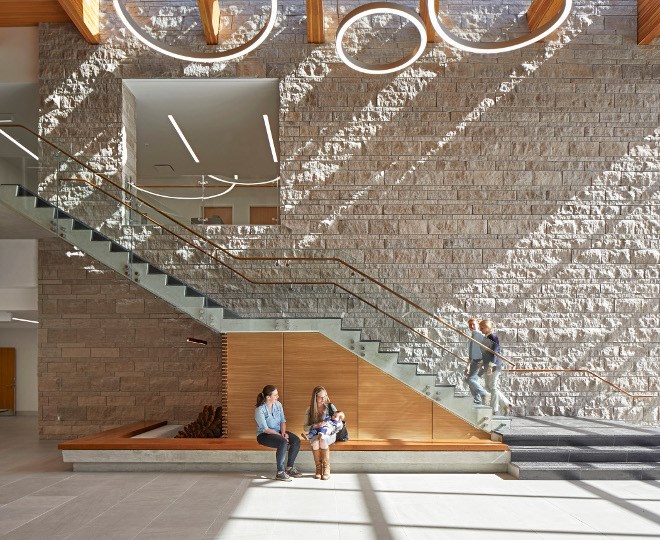National and provincial accolades earned by a North Bay architecture firm are shining a spotlight on Northern Ontario design as a reflection of the region’s unique attributes.
Last summer, Mitchell Jensen Architects’ design of the North Bay-Parry Sound District Health Unit, in collaboration with Ottawa’s Carlyle Design Associates, was recognized by Canadian Interiors Magazine as Best in Canada, in the institutional category.
Then, in November, the same project won the Northern Ontario Excellence Award from Ontario WoodWORKS!, an initiative of the Canadian Wood Council.
Opened this past June, the two-storey, 58,000-square-foot facility was lauded for its use of natural materials, including Douglas fir and limestone; the inclusion of plenty of windows to let in natural light; and its proximity to public transportation, walking trails, Lake Nipissing and other recreational activities, which is in keeping with the health unit’s mandate to promote healthy lifestyles. More than 30 works of art by local artists are showcased throughout the building.
Consulting architect Paul Mitchell said the awards are a memorable distinction to cap off a project that held special meaning for the firm.
“I think being more intimately aware of the values that community holds dear, which we share, and our friends and colleagues that we work with share, help us to be more reflective and more supportive of the communities that we serve,” he said. “We like to be very consultative and we like to become very engaged with our clients.”
Some of the firm’s other projects of note include the Kinoomaadziwin Education Body building on the Nipissing First Nation; the Jack Garland Airport terminal in North Bay; and One Kids Place, a North Bay treatment centre for children with disabilities. The latter was also a design award winner, earning the Project of the Year Award from the Association of Registered Interior Designers of Ontario, as well as another Ontario WoodWORKS! award.
Formed in 1964, Mitchell Jensen Architects has designed buildings across industries – commercial, community, education, health, Indigenous and residential. Currently led by five shareholders, the firm has 12 staff members, two of whom operate out of a satellite site in Huntsville, which serves the Muskoka region. And with a portfolio full of upcoming projects, the firm is hiring.
“We’re always anxious to find talented people to join our team,” Mitchell said. “Our team is what we can offer the market, so the bigger and better our team, the more offering we have.”
Awards are a nice feather in the company’s cap, but perhaps even more important is the occasion they provide to showcase Northern Ontario architecture, which can often be overshadowed by design from the southern part of the province, noted Nathan Jensen, principal architect.
Fundamentally, he said, there’s an ongoing need for discourse around urban design and planning and its significance in creating beautiful communities that serve the people who live there.
“First and foremost, we want to design buildings that make people’s lives better, where they want to work there, they want to live there, they want to be there,” he said. “That’s the joy for us as architects – to have people love to be in our buildings.”
But that conversation hasn’t been as common in Northern Ontario, which is more of a collective of smaller communities, as it has in larger urban centres, Jensen said. Representation in the media and in awards help raise the level of awareness about the importance of Northern architecture to help people appreciate that “great architecture can and does happen all over the place – it’s not just in the big cities.”
Designing architecture for Indigenous communities is a growing area of focus and interest for the firm.
It’s challenging and interesting to figure out how to serve Indigenous communities in a culturally appropriate way, Mitchell said, a key part of which is listening and learning.
Community Elders, who he said have been patient and generous with their time, are particularly valuable resources of cultural wisdom and knowledge that helps inform the consultation process.
“There isn’t a base of archetypes for Indigenous architecture in the modern world, so we’re kind of on new ground,” Mitchell said.
“That’s very exciting to try and explore, and to explore in a meaningful way, to make sure it’s not just pastiche or decoration that makes it Indigenous, but there are some fundamental values reflected in the building which are appropriate for the cultures that we’re trying to serve.”



